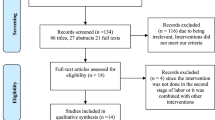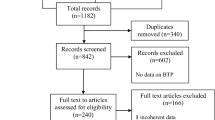Abstract
Background
Most women suffer from perineal trauma during childbirth, whether it is natural tears or episiotomy.
Objectives
To perform a systematic review and network meta-analysis investigating the effectiveness of different PFMT relevant strategies in the prevention of perineal trauma.
Search strategy
PubMed, Embase, the Cochrane Library, CINAHL, CNKI, CBM, WANFANG DATABASE, and ClinicalTrials.gov were searched for citations published in any language from inception to 1 July 2021.
Selection criteria
Randomized controlled trials (RCTs) of PFMT relevant prevention strategies for preventing perineal trauma during childbirth.
Data collection and analysis
Data were independently extracted by two reviewers. Relative treatment effects were estimated using network meta-analysis (NMA).
Main results
Of 12 632 citations searched, 21 RCTs were included. Comparing with usual care, “PFMT combine with perineal massage” and PFMT alone showed more superiority in intact perineum (RR = 5.37, 95% CI: 3.79 to 7.60, moderate certainty; RR = 2.58, 95% CI 1.34–4.97, moderate certainty, respectively), episiotomy (RR = 0.26, 95% CI 0.14–0.49, very low certainty; RR = 0.63, 95% CI 0.45–0.90, very low certainty, respectively), and OASIS (RR = 0.35, 95% CI 0.16–0.78, moderate certainty; RR = 0.49, 95% CI 0.28–0.85, high certainty, respectively). “PFMT combine with perineal massage” showed superiority in reducing perineal tear (RR = 0.41, 95% CI 0.20–0.85, moderate certainty).
Conclusions
In view of the results, antenatal “PFMT combine with perineal massage” and PFMT were effective strategies for the prevention of perineal trauma.




Similar content being viewed by others
References
American College of Obstetricians and Gynecologists’ Committee on Practice Bulletins—Obstetrics (2016) Practice bulletin No 165: prevention and management of obstetric lacerations at vaginal delivery. Obstet Gynecol 128(1):e1-e15. DOI: https://doi.org/10.1097/AOG.0000000000001523.
Queensland Health (2020). Mothers birthing in Queensland 2020. https://www.health.qld.gov.au/__data/assets/pdf_file/0019/1130491/6-labdel2020.pdf (Accessed 20 May 2022).
World Health Organization (2016). Standards for improving quality of maternal and newborn care in health facilities. Geneva: World Health Organization. https://www.who.int/publications-detail-redirect/9789241511216 (Accessed 20 May 2022).
Queensland Health (2020). Queensland Clinical Guidelines: Perineal care. https://www.health.qld.gov.au/__data/assets/pdf_file/0022/142384/g-pericare.pdf (Accessed 20 May 2022).
Waldman R (2019) ACOG practice bulletin no. 198: Prevention and management of obstetric lacerations at vaginal delivery. Obstet Gynecol 133(1):185. https://doi.org/10.1097/AOG.0000000000003041
Ducarme G, Pizzoferrato AC, de Tayrac R, Schantz C, Thubert T, Le Ray C et al (2019) Perineal prevention and protection in obstetrics: CNGOF clinical practice guidelines. J Gynecol Obstet Hum Reprod 48(7):455–460. https://doi.org/10.1016/j.jogoh.2018.12.002
Abdelhakim AM, Eldesouky E, Elmagd IA, Mohammed A, Farag EA, Mohammed AE et al (2020) Antenatal perineal massage benefits in reducing perineal trauma and postpartum morbidities: a systematic review and meta-analysis of randomized controlled trials. Int Urogynecol J 31(9):1735–1745. https://doi.org/10.1007/s00192-020-04302-8
Gomes Lopes L, Maia Dutra Balsells M, Teixeira Moreira Vasconcelos C, Leite de Araújo T, Teixeira Lima FE, de Souza AP (2022) Can pelvic floor muscle training prevent perineal laceration? A systematic review and meta- analysis. Int J Gynaecol Obstet 157(2):248–254. https://doi.org/10.1002/ijgo.13826
Brito LG, Ferreira CH, Duarte G, Nogueira AA, Marcolin AC (2015) Antepartum use of Epi-No birth trainer for preventing perineal trauma: systematic review. Int Urogynecol J 26(10):1429–1436. https://doi.org/10.1007/s00192-015-2687-8
Masoud AT, AbdelGawad MM, Elshamy NH, Mohamed OM, Hashem ZY, Abd Eltawab AK et al (2020) The effect of antenatal exercise on delivery outcomes: a systematic review and meta-analysis of randomized controlled trials. J Gynecol Obstet Hum Reprod 49(6):101736. https://doi.org/10.1016/j.jogoh.2020.101736
Hutton B, Salanti G, Caldwell DM, Chaimani A, Schmid CH, Cameron C et al (2015) The PRISMA extension statement for reporting of systematic reviews incorporating network meta-analyses of health care strategies: checklist and explanations. Ann Intern Med 162(11):777–784. https://doi.org/10.7326/M14-2385
Cumpston MS, McKenzie JE, Welch VA, Brennan SE (2022). Strengthening systematic reviews in public health: guidance in the Cochrane Handbook for Systematic Reviews of Interventions, 2nd edition. J Public Health (Oxf) 28:fdac036. Doi: https://doi.org/10.1093/pubmed/fdac036.
Rücker G (2012) Network meta-analysis, electrical networks and graph theory. Res Synth Methods 3(4):312–324. https://doi.org/10.1002/jrsm.1058
Chaimani A, Higgins JP, Mavridis D, Spyridonos P, Salanti G (2013) Graphical tools for network meta-analysis in STATA. PLoS ONE 8(10):e76654. https://doi.org/10.1371/journal.pone.0076654
Higgins JPT, Jackson D, Barrett JK, Lu G, Ades aE, White IR (2012) Consistency and inconsistency in network meta-analysis: concepts and models for multi-arm studies. Res Synth Methods 3(2):98–110. https://doi.org/10.1002/jrsm.1044
Dias S, Welton NJ, Caldwell DM, Ades AE (2010) Checking consistency in mixed strategies comparison meta-analysis. Stat Med 29(7–8):932–944. https://doi.org/10.1002/sim.3767
Krahn U, Binder H, König J (2013) A graphical tool for locating inconsistency in network meta-analyses. BMC Med Res Methodol 13:35. https://doi.org/10.1186/1471-2288-13-35
Rücker G, Schwarzer G (2015) Ranking treatments in frequentist network meta-analysis works without resampling methods. BMC Med Res Methodol 15:58. https://doi.org/10.1186/s12874-015-0060-8
Brignardello-Petersen R, Bonner A, Alexander PE, Siemieniuk RA, Furukawa TA, Rochwerg B et al (2018) Advances in the GRADE approach to rate the certainty in estimates from a network meta-analysis. J Clin Epidemiol 93:36–44. https://doi.org/10.1016/j.jclinepi.2017.10.005
Brignardello-Petersen R, Florez ID, Izcovich A, Santesso N, Hazlewood G, Alhazanni W et al (2020) GRADE approach to drawing conclusions from a network meta-analysis using a minimally contextualized framework. BMJ 371:m3900. https://doi.org/10.1136/bmj.m3900
Agur W, Steggles P, Waterfield M, Freeman R (2008) Does antenatal pelvic floor muscle training affect the outcome of labour? A randomised controlled trial. Int Urogynecol J Pelvic Floor Dysfunct 19(1):85–88. https://doi.org/10.1007/s00192-007-0391-z
Dias LA, Driusso P, Aita DL, Bø K, Ferreira CHJ (2011) Effect of pelvic floor muscle training on labour and newborn outcomes: a randomized controlled trial. Rev Bras Fisioter 15(6):487–493. https://doi.org/10.1590/s1413-35552011005000011
Dieb AS, Shoab AY, Nabil H, Gabr A, Abdallah AA, Shaban MM et al (2020) Perineal massage and training reduce perineal trauma in pregnant women older than 35 years: a randomized controlled trial. Int Urogynecol J 31(3):613–619. https://doi.org/10.1007/s00192-019-03937-6
HP Dietz,S Langer,K Atan,KL Shek,J Caudwell-Hall,RG Rojas (2014). Does the Epi-No birth trainer prevent vaginal birth-related pelvic floor trauma? A multicenter prospective randomised controlled trial. 44th Annual Meeting of the International-Continence-Society (ICS)Volume: 33
Lekskulchai O, Wanichsetakul P (2014) Effect of pelvic floor muscle training (PFMT) during pregnancy on bladder neck descend and delivery. J Med Assoc Thai 97(Suppl 8):S156–S163
Kamisan Atan I, Shek KL, Langer S, Guzman Rojas R, Caudwell-Hall J, Daly JO, Dietz HP (2016) Does the Epi-No(®) birth trainer prevent vaginal birth-related pelvic floor trauma? A multicentre prospective randomised controlled trial. BJOG 123(6):995–1003. https://doi.org/10.1111/1471-0528.13924
Leon-Larios F, Corrales-Gutierrez I, Casado-Mejía R, Suarez-Serrano C (2017) Influence of a pelvic floor training programme to prevent perineal trauma: a quasi-randomised controlled trial. Midwifery 50:72–77. https://doi.org/10.1016/j.midw.2017.03.015
Rodríguez-Díaz L, Ruiz-Frutos C, Vázquez-Lara JM, Ramírez-Rodrigo J, Villaverde-Gutiérrez C, Torres-Luque G (2017) Effectiveness of a physical activity programme based on the Pilates method in pregnancy and labour. Enferm Clin 27(5):271–277. https://doi.org/10.1016/j.enfcli.2017.05.008
Ruckhäberle E, Jundt K, Bäuerle M, Brisch KH, Ulm K, Dannecker C et al (2009) Prospective randomised multicentre trial with the birth trainer EPI-NO for the prevention of perineal trauma. Aust N Z J Obstet Gynaecol 49(5):478–483. https://doi.org/10.1111/j.1479-828X.2009.01044.x
Shek KL, Chantarasorn V, Langer S, Phipps H, Dietz HP (2011) Does the Epi-No Birth Trainer reduce levator trauma? A randomised controlled trial. Int Urogynecol J 22(12):1521–1528. https://doi.org/10.1007/s00192-011-1517-x
Deng XP (2019) Significance of pelvic floor muscle function exercise guidance for primiparas who give birth naturally. Contemp Med Essays 17(10):9–11
Huang JL, Yan Q, Shen SW, You WH, Huang LX (2020) The effect of perineal massage combined with Kegel exercise during pregnancy on the delivery outcome of primipara. China Pract Med 15(21):35–37. https://doi.org/10.14163/j.cnki.11-5547/r.2020.21.013
Shi S (2018) The influence of yoga during pregnancy on pregnancy outcome of primipara. China Urban Rural Ent Health 33(06):46–48. https://doi.org/10.16286/j.1003-5052.2018.06.018
Salvesen KA, Mørkved S (2004) Randomised controlled trial of pelvic floor muscle training during pregnancy. BMJ 329(7462):378–380. https://doi.org/10.1136/bmj.38163.724306.3A
Wang K (2015) Clinical research on PFMT behavior guidance for pregnant and lying-in women before and after childbirth. J Inn Mong Med Univ 37(S1):301–303. https://doi.org/10.16343/j.cnki.issn.2095-512x.2015.s1.076
Wang Y, Zhou GL, Zou HY, Wang CX, Xiao SL, Pan JF et al (2015) Study on the effect of modified Kegel functional exercise nursing on the delivery method of pregnant women with pelvic floor dysfunction. Mod Diagnosis Treat 26(18):4294–4295
Cai HL (2019) The effect of antenatal perineal massage combined with Kegel exercise on the delivery outcome of primipara. Nurs Pract Res 16(17):87–89. https://doi.org/10.3969/j.issn.1672-9676.2019.17.039
Liang H (2020) The effect of antenatal perineal massage combined with Kegel exercise on the delivery outcome of primipara. Nurs Pract Res 17(18):101–103. https://doi.org/10.3969/j.issn.1672-9676.2020.18.039
Hu Z, Qi GH, Wu YH (2014) The effect of continuous guidance of pelvic floor muscle exercise on the maternal and infant delivery outcome of primipara. Hainan Medicine 25(09):1351–1352
Kovacs GT, Heath P, Heather C (2004) First Australian trial of the birth-training device Epi-No: a highly significantly increased chance of an intact perineum. Aust N Z J Obstet Gynaecol 44(4):347–348. https://doi.org/10.1111/j.1479-828X.2004.00265.x
Wang M, Zhang HH (2017) The application effect of perineal massage combined with Kegel exercise in the natural delivery of primipara in the third trimester of pregnancy. Nurs Res 31(33):4243–4246. https://doi.org/10.3969/j.issn.1009-6493.2017.33.017
Acknowledgements
This research not supported by any institution or individual.
Funding
The authors have not disclosed any funding.
Author information
Authors and Affiliations
Contributions
XC: the conception of the work, the acquisition, analysis, and interpretation of data for the work, draft and revise the work. QYY: the conception of the work, the acquisition, analysis, and interpretation of data for the work. QW: the conception of the work, the acquisition, analysis, and interpretation of data for the work, revise the work. SH: the design of the work, the acquisition, analysis, and interpretation of data for the work. LH: the conception of the work, the acquisition, analysis, and interpretation of data for the work, revise the work. MS: the conception of the work, the acquisition, analysis, and interpretation of data for the work. HL: the conception of the work, the acquisition, analysis, and interpretation of data for the work, revise the work. CW: the conception of the work, the acquisition, analysis, and interpretation of data for the work. YW: the conception of the work, the acquisition, analysis, and interpretation of data for the work. LX: the design of the work, the acquisition, analysis, and interpretation of data for the work, revise the work. XL: the design of the work, revise the manuscript, final approval of the version to be published. JT: the design of the work, revise the manuscript, final approval of the version to be published. LG: the conception and design of the work, revise the manuscript, final approval of the version to be published, coordinate the overall work. CL: t the conception and design of the work, revise the manuscript, final approval of the version to be published, coordinate the overall work.
Corresponding authors
Ethics declarations
Conflict of interest
The authors have not disclosed any competing interests.
Additional information
Publisher's Note
Springer Nature remains neutral with regard to jurisdictional claims in published maps and institutional affiliations.
Rights and permissions
Springer Nature or its licensor holds exclusive rights to this article under a publishing agreement with the author(s) or other rightsholder(s); author self-archiving of the accepted manuscript version of this article is solely governed by the terms of such publishing agreement and applicable law.
About this article
Cite this article
Cao, X., Yang, Q., Wang, Q. et al. PFMT relevant strategies to prevent perineal trauma: a systematic review and network meta-analysis. Arch Gynecol Obstet 308, 387–401 (2023). https://doi.org/10.1007/s00404-022-06769-w
Received:
Accepted:
Published:
Issue Date:
DOI: https://doi.org/10.1007/s00404-022-06769-w

































